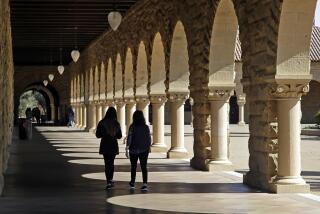Army Corps’ Help Sought in Belmont Decision
- Share via
Los Angeles school officials said Wednesday that they want the U.S. Army Corps of Engineers to help them decide whether the environmentally plagued Belmont Learning Complex can be made safe to open and at a reasonable cost.
District chief operating officer Howard Miller said he and soon-to-be interim Supt. Ramon Cortines will ask the Board of Education on Tuesday to approve a six-week study by the corps, a new delay that would put off a decision on the half-completed high school until early February.
Miller said he cannot now make a final recommendation on Belmont, because questions about its safety and cost remain unanswered despite a two-month evaluation by a commission appointed by the board in August.
He made the announcement at a meeting of about 200 students, teachers and parents at the current Belmont, a few blocks from the new school, now being put in mothballs until a decision is made.
Board President Genethia Hayes used the setting to modify her own position on Belmont, saying that she no longer views cost as a consideration.
“My only issue is safety,” Hayes said after listening to about a dozen students vent their frustration over the project’s delay. “I agree with the students who say it can’t be about anything else. . . . Not whether the school is going to be costly. That is not the issue for me.”
Hayes, one of three reform-minded candidates who attacked Belmont during this spring’s board election campaign, has previously said that she would not support spending any more than $20 million to mitigate explosive methane and toxic hydrogen sulfide on the former oil field site west of downtown.
Hayes is one of four board members who have said they are leaning toward abandoning the $200-million project. She said Wednesday that she has not made up her mind.
Cortines, who spoke to the crowd briefly before leaving to meet with the teachers union, reiterated his support for completing Belmont but said safety issues must come first.
“While I want it open, that is an emotional, heartfelt feeling that it needs to be open on behalf of this community. But also I want it to be safe and healthy for the students and for the adults,” Cortines said.
Miller said he and Cortines had decided only shortly before the meeting to engage the corps in Belmont to fill in the details left unanswered by the commission, which voted 4 to 3 in October to recommend completing the 5,000-student high school.
The recommendation included a strongly worded minority report saying that the school should not be built because it would cost about the same and take as long as building an entirely new school on land without environmental problems.
On Monday, Miller signed an agreement to make the corps responsible for managing the district’s ambitious plan to build 150 primary centers and reconfigure middle schools into high schools to accommodate tens of thousands of new students anticipated in the next decade.
At the time, he declined to respond to speculation that the corps would become involved in Belmont, saying that was a separate issue.
The corps’ role in Belmont caused some to question whether there is a conflict of interest involving O’Melveny & Myers, the law firm that negotiated the contract to build the school, and which is now being sued by the district for alleged malpractice. Secretary of the Army Louis Caldera, a former assemblyman from Los Angeles, once worked for the firm.
Miller dismissed the suggestion that a conflict exists, saying Caldera had nothing to do with the agreement.
The meeting at Belmont was organized by state Assemblyman Gil Cedillo (D-Los Angeles), who said he hoped that it would get past the emotions that have driven the Belmont debate. Only two board members attended, because the date had been changed at the last minute and others had scheduling conflicts.
Many of the students pleaded with the board members to finish the school.
“Why are we still here?” asked Isaac Jimenez. “Why is this still happening? What have we done to deserve this?”
They said their current campus is unsafe.
“I don’t think you all see it the way we see it,” said student David Avila, one of about a dozen speakers. “[What] if there is an earthquake, and there are 5,000 students trying to get down the staircase.”
Miller said he would form a committee of the school’s students, teachers and parents to be involved in all future decisions on Belmont and other new schools.
“We will have you interacting with us, so we finally have the same information necessary to make the decision.’
More to Read
Sign up for Essential California
The most important California stories and recommendations in your inbox every morning.
You may occasionally receive promotional content from the Los Angeles Times.













